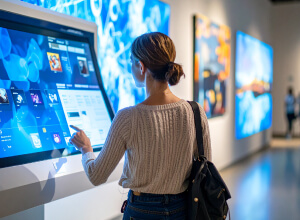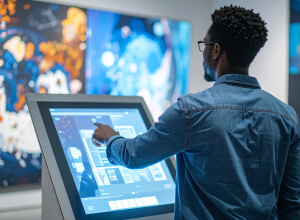Coronavirus & Interactive Signage: What's the Right Move?

How should interactive signage be used in the low-interaction climate of a pandemic?
Also read about our COVID-19 Measures where we share Intuiface's operational response to reassure you that we are staffed and organized to support you during these challenging times.
Let me start by warning you that this article will not do any good for the overpopulation of coronavirus stories online. However, give it a chance by finishing this intro. I think you’ll find it will be worth your while.
Since the first cases officially reported just a little over three months ago, the confirmed active global cases of COVID-19 have been climbing at an incomprehensible level to more than 148,000 as of today, March 19, 2020 (Check this resource for updated information). Although 95% of those cases are mild, the death toll is far from zero and has been continuously rising (source). The virus' atypical development patterns and the lack of a cure has put a lot of us in panic mode with concern about contamination and socio-economic changes.
Digital Signage Solution Providers Concerns
These concerns includes us: interactive digital signage solution providers and users. After all, the world of interactive digital signage and the Coronavirus epidemic have one hot potato in common – interaction through touch – a mode of disease transmission we are asked to avoid.
With digital signage as widespread as it is, a world of questions presents itself. Are we taking the matter lightly, or are we over-reacting? What can we do as users and providers of interactive displays? Does this mean “death” to all public interactive displays? How can we sustain business as usual and in such an unusual environment?
It is hard to give definitive answers to these questions since, as mentioned, the disease is unprecedented in both distribution and severity. However, this is not the first time we have faced the threat of a viral outbreak. There have been other diseases that devastated global human populations, such as the recent worldwide epidemics for H1N1, Ebola, and SARs. (source)
If there is one lesson we’ve learned from those past experiences, it is that we need explicit information sharing based on facts, open communication about inconvenient truths, and, most importantly, proactive (rather than reactive) actions.
On that account, this article will attempt to help all of us act on those lessons by tackling three subjects. Remember, this article focuses specifically on the world of interactive digital signage:
- Coronavirus fact vs. fiction
- Industry reality check
- Proactive Countermeasures: if not now, then for the next time
Coronavirus Fact vs. Fiction
(The following guidance is based on information shared by trusted, referenced sources. However, readers must still use their own judgment when making health-related decisions in light of personal priority and the fast-evolving circumstances of the COVID-19 epidemic.)
1. Devices shipped from overseas and their packaging can transmit the Coronavirus. We need to stop all hardware deliveries.
NO: Scientists note that most viruses like this one do not stay alive for very long on surfaces. Most virus particles degrade in a matter of minutes or hours outside a living host, and the quantity of infectious particles goes down exponentially over time. So, it is not likely you would get COVID-19 from a package that was in transit for days or weeks (source).
2. Touch (with surfaces, objects, or a patient) is the primary route of infection. So, touchscreens are more dangerous than quick human interactions.
NO: Touching in itself does not transmit the disease. Even touching a patient in itself wouldn’t get you sick. The virus travels through mucus and saliva droplets, which are ejected from the mouth or nose as we cough, sneeze, laugh, sing, breathe, and talk. For them to cause infection, the viral droplets must enter through the eyes, nose, or mouth. If airborne virus particles don’t hit something along the way, they typically land on the floor or ground.
Health authorities still recommend that people take steps to clean and disinfect surfaces, but it’s fair to say that interacting with machines such as self-service kiosks poses less risk than interacting with another person directly as long as we don’t touch our face and clean our hands afterward (source).

3. Coronavirus is invincible so efforts tin disinfecting touchscreens won’t do any good!
NO: As mentioned, not only will the virus degrade in a matter of minutes or hours outside a living host, health experts say Coronaviruses are relatively easy to destroy. Disinfecting touchscreens is nearly guaranteed nearly guaranteed to break the delicate envelope that surrounds the tiny microbe, rendering it harmless (source).
Industry Reality Check
Do you remember the McDonald’s fecal fiasco (source)? Sorry to refresh your memory, especially if you are a burger chain goer like myself. Back in 2018, touchscreens at several McDonald’s restaurants in the UK tested positive for traces of feces and harmful bacteria. Back then, the QSR chain reacted with statements such as this:
“Our self-order screens are cleaned frequently throughout the day. All of our restaurants also provide facilities for customers to wash their hands before eating.”
Others also pushed back by claiming that the detected bacteria don’t pose a real threat to our health and that the whole story was exaggerated (source). As time passed, despite few visible changes on the restaurant side and some temporary loss of appetite (pardon the pun) for use of self-service kiosks, life seems to have moved on. Touchscreen sanitation concerns cooled off; people went back to appreciating the modern self-service technology. Sounds like a happy ending… Not quite.
Let’s talk about how that “lesson” prepared us for everything that’s happened over the last three months with the spread of Coronavirus.
Although the situation might change as the current pandemic evolves, so far in the case of the UK, none of the biggest businesses, including the supermarket brands(Tesco, Asda and Sainsbury’s), McDonald’s, and cinemas, have revealed plans regarding their touch screens (source). On the whole, the brands seem to be willing to pursue business as usual, while echoing commonly shared public health authority advice: wash hands frequently with soap or using alcohol gel.
In the US, some QSR branches closed down the dining area while still operating thedrive-thru, walk-in take-out, and delivery services (source).
In addition, globally, brick and mortar stores, as well as other crowded places such as museums, cultural, and educational institutions, are either being locked down or witnessing dramatic thinning of traffic (source).
Consequently, interactive displace service providers and manufacturers are adapting to the rapid and global situation (source). For example, US-based kiosk manufacturer Fabcon admitted that the company’s supply chain has been severely impacted by products they procure and import from China and Taiwan and that they have had to adjust their production lead times.
Similarly, FlowVella, a Seattle-based multi-media solutions specialist that provides a kiosk app for iPads, has experienced a decline in activity from both trade show and museum customers, which account for half of the company’s business.
We cannot deny that all of these changes following the Coronavirus outbreak are unavoidable. Locking down crowded places to impose social distancing seems by far the safest practice in the meantime, and the slowdown of business and social activities is only a natural phenomenon.
However, reality has exposed a lack of foresight, the lack of proactive and strategic practices for technology providers and the industry as a whole.
What are some proactive measures we can take as an industry to make sure we're on top of these periodic viral epidemics if not for this time, then for next time?
Read on.
Proactive Countermeasures: If Not For Now, Then For Next Time

We can’t be completely free of the unpredictable power of nature, and history has reminded us of our vulnerability through the re-emergence of infectious diseases (source). COVID-19 aside, the spread of an infectious disease was more than anticipated. It just wasn’t warned in advance, as always.
The obvious question then follows: What are some proactive measures we can take as an industry to make sure we're on top of these repeating virus epidemics if not for this time, then for next time? Instead of having to lock down stores and halt business activities, is there a way to survive and possibly even thrive?
Have health-centered preparedness and proactivity at the core.
If this is a non-existing part of your business philosophy, implement it now. It is often taught that preparedness and proactiveness are keys to success. Applying the same strategy in the context of health security is only logical, especially when we have learned from the past and the ongoing outbreak that epidemics like this can have a damaging socio-economic impact. It might sound like a theoretical phrase, but the determination to have health-sensitive preparedness and proactivity will protect parts of your business.
Note though that this will only work when all industry players are on board together because whether it’s a product, service, or interactive kiosk, public perception matters, and that’s not something one individual player can control.
Do you have health-sensitive preparedness and proactivity under your belt? Then let’s get practical: what is to be done?
Communicate openly about the inconvenient truth
Here is a set of things that will likely happen whenever there is a virus outbreak (source). There is (a) an initial collective delay in recognizing and communicating about it; (b) a serious impact on socio-economic activities; (c) people are kept in the dark, receive false information, reacting with anxiety, panic and confusion (d) aided and abetted by media coverage (e) resulting in business lock-downs.
The plan now is to address Step A by openly communicating about the use of interactive displays during a viral epidemic. Being completely transparent about risks and countermeasures in times like this can help build customer trust in a brand and confidence in using their services.
For example, don’t leave your interactive displays looking nonchalant. Visibly display the risk of using touchscreens and how it can still be safe to use it when accompanied by disinfecting the device and cleaning hands. State clearly how the installation is managed to ensure safety and then follow through. Let the users know how direct human interaction poses the highest risk and that your interactive installations are there to still serve their needs as usual. People will thank you and come back to look for your services and products.
The classic: disinfectants
A classic and obvious but also the most straightforward solution: use disinfectants. Make alcohol-based sanitizers (either in gel, spray, or wipe form) easily accessible using an automatic dispenser adjacent to your tablet menus, POS, and wayfinding kiosks. Disinfect your installations as often as possible and do these consistently and in full view. It shouldn’t be a temporary gesture to impress the users but a consistent part of your service. Integrate the dispenser into your installations, if possible. Here is a list of products that have been pre-approved by US Environmental Protection Agency (EPA) for use against emerging enveloped viral pathogens and can be used during the novel Coronavirus (COVID-19) outbreak.
Also, read Intuiface Partner Elo’s guidelines for cleaning their touchscreens.
Adopt interactive technologies other than touch: Turn disaster into creative opportunity
Adopt interactive technologies other than touch. Think outside the box and turn disaster into a creative opportunity. If touching surfaces pose a risk, then it doesn’t have to be the only way to interact with public displays. After all, public digital signage and kiosks have fully integrated into our daily lives; we ought to evolve them rather than give up.
The good news is that we already have the means to implement such an advancement. With interactive no code software solutions like Intuiface, you can integrate diverse touch-free ways for visitors to engage with interactive displays in a time and cost-efficient way. For example, use RFID/NFC readers to trigger payment processing or display individualized information. Adopt Web triggering, enabling visitors to remotely drive on-screen content using their own mobile devices. How about voice activation? Intuiface supports use of the spoken word, capturing information or reacting to commands activated from popular services like Amazon Alexa and Google Home with any of 200+ possible on-screen or behind-the-scenes actions. This feature can be not only useful for preventing the spread of a virus but also for creating accessible experiences for those who can't effectively touch the display. Demographic-based interactions – through computer vision - and motion sensors are some of the other non-touch interactions you can offer on your installations.
Learn more on https://www.intuiface.com/beyond-touch
With beyond-touch interactive technologies like these, who wouldn’t come back for your services amidst the fear of virus transmission when they know they are safer doing business with you?
Adopting diverse and advanced interactive technologies might sound like an inessential gesture. But remember, preparedness and proactiveness will put you on the path to a sustainable business even in tough times.





